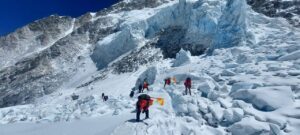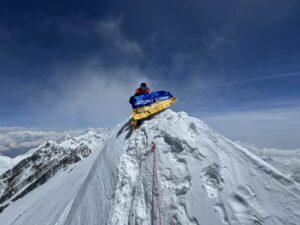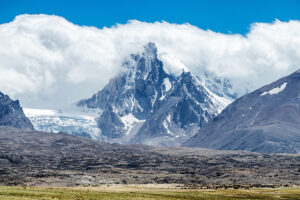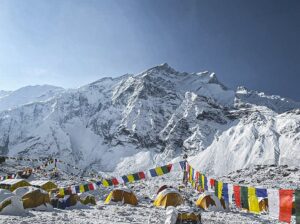Kenro Nakajima and Kazuya Hiraide won the coveted Piolet d’Or last year for their difficult first ascent of the northeast face of Shispare. This past July, they continued their groundbreaking work with a new route up the south face of 7,788m Rakaposhi, in the Gilgit-Baltistan region of the Karakorum. Rakaposhi was first ascended in 1958 by Mike Banks and Tom Patey, part of a British-Pakistani expedition, via the Southwest Ridge. Since then, Rakaposhi has been summited from the east side, the Northwest Ridge and the North Spur. Unsuccessful attempts have also been made via the Bagrote Glacier, the East Ridge and the North Face.
Nakajima and Hiraide weren’t planning to do Rakaposhi this year. Their primary objective was Tirich Mir Main (7,708m). But as they waited for a permit to be granted, and the days ticked away without word, they eventually sought an alternative.

Courtesy of Kenro Nakajima
Hiraide knew the Hunza Valley intimately, since he has made it one of his life goals to climb all its peaks. They decided to scout the south side of Rakaposhi. Other parties had reconnoitered that line in the past but weren’t able to find a feasible route, so it remained untouched.

Between C1 and C2. The peak of Rakaposhi looms against a cobalt-blue stratosphere in the central background. Photo: Kenro Nakajima
On June 16, they set up Base Camp in a grassy valley amid the grazing yaks and goats. They spent three days acclimatizing and reconnoitering the potential route. The pair overnighted at 4,500m and 5,900m, then reached 6,100m before returning to BC.
Here, they endured rain and sleet for six days, while distant avalanches echoed through the valley. When the weather finally broke, the forecast gave them a couple of days of cloud, some unsettled weather, followed by a narrow but promising window of sun and calm. That was their play.

Between C1 and C2. Photo: Kenro Nakajima
They left on June 27 under the predicted cloudy skies, with food and fuel for seven days. After 1,500m of climbing, they shoveled out a platform at a col at 5,200m. The next day, they struggled through fresh snow and past seracs to the foot of an ice wall, sometimes doffing their packs to break trail. They managed to gain a further 1,000m and pitched C2 at 6,200m.
On June 29, they finally reached the southeast ridge, which they mounted by planting ice screws on the ice wall just beneath the ridge. Soft snow posed a challenge, but they managed to ascend 600m, where they dug out Camp 3. Here, the weather crapped out, as expected, and they hunkered down on June 30 and July 1 during a heavy snowfall.

Summit push from C3. Photo: Kenro Nakajima
Considering the narrow weather window ahead, they decided that they would make their final push to the summit from C3. At 4am on July 2, they left camp and topped out at noon. The panoramic view including Shispare, the scene of their first ascent the previous year, and K2 in the distance.
They descended the same way, overnighted at C3 and returned to Base Camp the following day. The route was not overly technical, they reported, but their climb from BC to summit surpassed 4,000m, in highly unstable weather.

The summit. Photo: Kenro Nakajima
ExWeb spoke briefly with Nakajima. He is unusually self-deprecating for a first-rate climber. He speaks slowly and pauses thoughtfully to consider his replies.
Tell us about how you and Hiraide work as a team.
We often climb as a pair, but we are different types of climber. Hiraide has more experience, while I am the stronger climber, even if I do say so myself. This means I usually lead, while Hiraide watches over me from behind. When I make a mistake, Hiraide lets me know it. It’s tough being in the lead, but the guy behind also has a heavy responsibility.
You guys seem to prefer alpine style. Is this for aesthetic or practical reasons?
The south face had a lot of snow and many seracs, so we really didn’t want to go back and forth too many times. This made alpine style the appropriate choice. Expedition style involves more work fixing ropes and carrying a heavier load. It also takes longer. This would have made us less agile and responsive. Of course, there are mountains and routes where alpine style simply doesn’t work, so I guess it’s a case of the right tool for the job. On the other hand, it may be true that we only choose routes where alpine style works.
Are you sponsored?
Hiraide has an athlete sponsorship with Ishii Sports, the Japanese outdoor and mountaineering retail store, but I work and have no sponsors, which means I cover the costs of my climbs myself. But our type of mountaineering isn’t too expensive, and Pakistan is particularly cheap – less than half the price of Nepal or Tibet.

Nanga Parbat and the Karakorum Highway in the background. Photo: Kenro Nakajima
How do you train for such an expedition?
Well, I do a bit of biking and running, but nothing special. Hiraide and I certainly don’t do any special training together. In fact, we don’t really get together until we go overseas. We are actually quite lazy compared to those professional athletes who train hard all the time. But mountaineering is mostly just walking. Of course, I climb from time to time, but not for training, for fun.

Between C2 and C3. Unnamed peak in the background. Photo: Kenro Nakajima
What is the mountaineering scene like in Japan?
The Japanese people work too hard and don’t have time for it. Most think that mountaineering is not part of their world. They respect it as a discipline, but feel it is not for them. Many other countries have lots of young climbers, but not here in Japan. But there are some worth following. In particular, Yusuke Sato, Katsutaka Yokoyama, and the Giri-Giri Boys* do some very interesting projects.
Finally, what is your next target?
We still want to climb Tirich Mir Main. Perhaps next year?
(*“Giri-Giri” means “barely” or “on the edge” in Japanese. The climbing group call themselves that because they feel they barely have enough money, experience or technique. At the same time, they pull off some incredible climbs.)

Nanga Parbat and Danyor Valley. Photo: Kenro Nakajima






